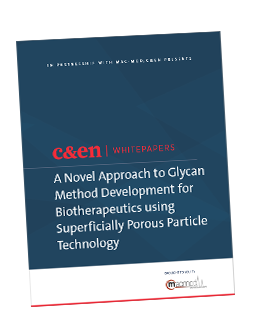
A Novel Approach to Glycan Method Development for Biotherapeutics using Superficialy Porous Particle Technology
Brought to you by Mac-Mod Analytical
Overview
Given the importance of glycosylation to overall performance of a glycoprotein, there is a need to completely characterize and then monitor these glycans for both research and manufacturing purposes. Traditional methods of analysis rely on cleavage of the glycans from the protein backbone, label with a UV- or fluorescence based tag, and separation and identification of the glycans by HPLC/MS. Following identification, the subsequent characterization and routine monitoring can be done using HPLC/UV or HPLC/fluorescence.
However, since the glycans attached to any protein come from a known set of glycans, the goal of this work was to develop and optimize a universal method to separate and completely characterize all potential glycans from any protein. This may entail a long, comprehensive analysis, which is acceptable since the characterization is done only a few times during product development. A second goal was to develop a rapid, routine method to be used for monitoring and control during process development or final manufacturing.
Key Objectives:
- Learn how to develop a glycan LC method utilizing method optimization software
- How to utilize a longer gradient method and a rapid gradient method to support in-process testing
- Review examples of the glycan method development process
Brought to you by:


Please complete the form to download the whitepaper.
By submitting this form, you agree to receive more information on related products and services from the American Chemical Society (ACS Publications) via email, in accordance with the ACS Privacy Policy .
Copyright © 2025 American Chemical Society | 1155 Sixteenth Street NW | Washington, DC 20036 | View our Privacy Policy